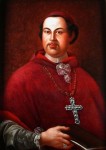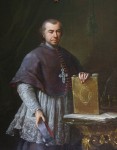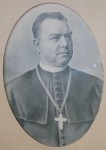 |
 |
 |
| The Episcopal Library contains the book bequest of former bishops of the diocese. Currently it holds 37 thousand volumes of books and periodicals, including very old and rare publications. The Episcopal Library was founded by Márton Padányi Biró, who was the bishop between1745 and 1762. He deposited his collection of 607 volumes in the palace he founded in Sümeg. His books were relocated to Veszprém at the beginning of the 20th century, the furniture of his library room is on display in the Museum of Applied Arts. (Read more about the Biró Library and its valuable books here) | His successor in the episcopal see was Ignác Nagymányai Koller (1762–1773). He built the episcopal palace in Veszprém. He established a library room with artistic furniture upstairs in the northern wing for the books he purchased. His 1671-volume collection includes 16th-century rarities (Find more illustrated information about the Koller Library here). | Hardly anything was left in Veszprém from the libraries of later bishops. Many of them were promoted to higher archiepiscopal sees and took along their libraries, while others did not leave their books to the diocese. The improvement of the Episcopal Library saw a boom at the end of the 19th century after the appointment of Cardinal Károly Hornig as Veszprém bishop. He brought Márton Biró’s library to Veszprém and donated its valuable furniture to the Museum of Applied Arts to ensure the safety and custody of both the book stock and the furniture. Hornig built his library consciously and passionately and promoted the research of the history of the diocese. The stock of his library was taken into inventory after his death in 1917, the result was 17346 volumes. This large stock forms the backbone of the Episcopal/Archiepiscopal Library. (You can find more information about cardinal Hornig's library by clicking here). |
Nándor Rott, Veszprém bishop between the two world wars, solved the joint management of the collections of Márton Biró, Ignác Koller and Károly Hornig by appointing master of ceremony Róbert Schwartz to librarian in 1928. After careful preparation he started with his brother to retake the huge stock into inventory and subsequently edit an author’s and a subject index. This work started in 1919, and since his brother left for Geneva, he himself took over the management of the protocollum and continued processing. After unmatched pace of work they achieved that every title was processed and available for researchers by the end of the year 1931. This means 21.500 volumes. Róbert Schwartz finishes the inventory with call number 25.863 on 31 July, 1942. In the meantime, due to lack of space the whole material was taken to the Körmendy house in 1938, from where in got back to the episcopal palace in 1948.
At the end of the 60's, the bulk chapter stock was transported from the cathedral to the episcopal palace in order to review the protected material as soon as possible. Since most of such volumes are in the seminary’s library, it was reasonable to make the whole stock reviewable. After all this demanding work they started to process the protected material.
After finishing the work it became clear that the Episcopal Library includes valuable codices, 26 incunables, 344 pieces from the 16th century, 118 works belonging to the Old Hungarian Library (RMK) series as well as 116 Hungarica-marked prints. The stock of the library is also enriched by valuable serieses, including the Elzevir volumes and the Migne-series.
The stock is continuously improved by bequests, donations and acquisitions supported by the budget. We must mention here the support of NKA (National Cultural Found of Hungary) and NKÖM (Ministry of National Cultural Heritage) provided annually for stock protection, due to which the 16th-century volumes are displayed to the visitors in carefully renewed conditions.
